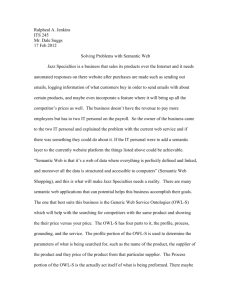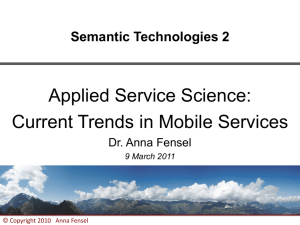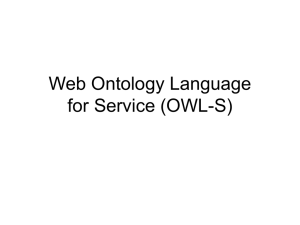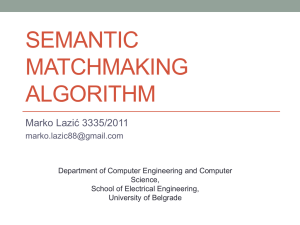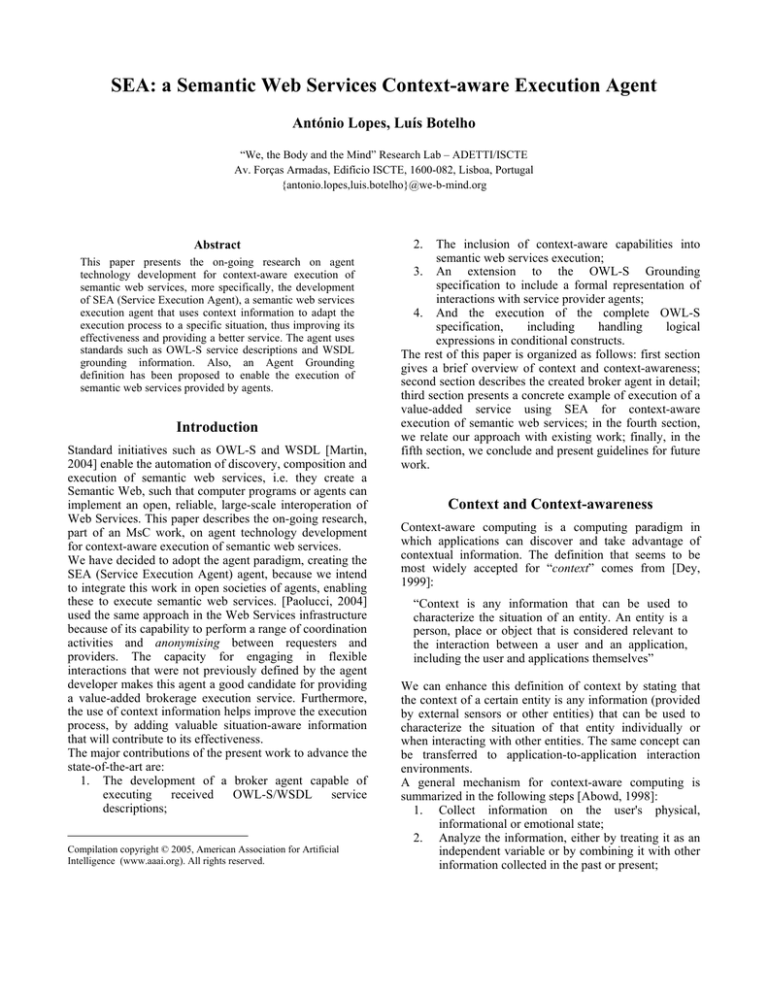
SEA: a Semantic Web Services Context-aware Execution Agent
António Lopes, Luís Botelho
“We, the Body and the Mind” Research Lab – ADETTI/ISCTE
Av. Forças Armadas, Edifício ISCTE, 1600-082, Lisboa, Portugal
{antonio.lopes,luis.botelho}@we-b-mind.org
Abstract
This paper presents the on-going research on agent
technology development for context-aware execution of
semantic web services, more specifically, the development
of SEA (Service Execution Agent), a semantic web services
execution agent that uses context information to adapt the
execution process to a specific situation, thus improving its
effectiveness and providing a better service. The agent uses
standards such as OWL-S service descriptions and WSDL
grounding information. Also, an Agent Grounding
definition has been proposed to enable the execution of
semantic web services provided by agents.
Introduction
Standard initiatives such as OWL-S and WSDL [Martin,
2004] enable the automation of discovery, composition and
execution of semantic web services, i.e. they create a
Semantic Web, such that computer programs or agents can
implement an open, reliable, large-scale interoperation of
Web Services. This paper describes the on-going research,
part of an MsC work, on agent technology development
for context-aware execution of semantic web services.
We have decided to adopt the agent paradigm, creating the
SEA (Service Execution Agent) agent, because we intend
to integrate this work in open societies of agents, enabling
these to execute semantic web services. [Paolucci, 2004]
used the same approach in the Web Services infrastructure
because of its capability to perform a range of coordination
activities and anonymising between requesters and
providers. The capacity for engaging in flexible
interactions that were not previously defined by the agent
developer makes this agent a good candidate for providing
a value-added brokerage execution service. Furthermore,
the use of context information helps improve the execution
process, by adding valuable situation-aware information
that will contribute to its effectiveness.
The major contributions of the present work to advance the
state-of-the-art are:
1. The development of a broker agent capable of
executing
received
OWL-S/WSDL
service
descriptions;
Compilation copyright © 2005, American Association for Artificial
Intelligence (www.aaai.org). All rights reserved.
2.
The inclusion of context-aware capabilities into
semantic web services execution;
3. An extension to the OWL-S Grounding
specification to include a formal representation of
interactions with service provider agents;
4. And the execution of the complete OWL-S
specification,
including
handling
logical
expressions in conditional constructs.
The rest of this paper is organized as follows: first section
gives a brief overview of context and context-awareness;
second section describes the created broker agent in detail;
third section presents a concrete example of execution of a
value-added service using SEA for context-aware
execution of semantic web services; in the fourth section,
we relate our approach with existing work; finally, in the
fifth section, we conclude and present guidelines for future
work.
Context and Context-awareness
Context-aware computing is a computing paradigm in
which applications can discover and take advantage of
contextual information. The definition that seems to be
most widely accepted for “context” comes from [Dey,
1999]:
“Context is any information that can be used to
characterize the situation of an entity. An entity is a
person, place or object that is considered relevant to
the interaction between a user and an application,
including the user and applications themselves”
We can enhance this definition of context by stating that
the context of a certain entity is any information (provided
by external sensors or other entities) that can be used to
characterize the situation of that entity individually or
when interacting with other entities. The same concept can
be transferred to application-to-application interaction
environments.
A general mechanism for context-aware computing is
summarized in the following steps [Abowd, 1998]:
1. Collect information on the user's physical,
informational or emotional state;
2. Analyze the information, either by treating it as an
independent variable or by combining it with other
information collected in the past or present;
3.
4.
Perform some action based on the analysis;
And repeat from step 1, with some adaptation
based on previous iterations.
SEA and context-awareness
SEA uses a similar approach to [Abowd, 1998] to enhance
its activity, by adapting it to the specific situation that the
agent and its client are involved in, at the time of the
execution process. The use of context information is not
only valuable for execution processes. [Broens, 2004]
describes the use of context information for enrichment of
the semantic web services discovery process.
SEA interacts with a generic context system [Costa, 2005]
in order to obtain context information, subscribe desired
context events and to provide relevant context information.
Other agents, web services and sensors (both software and
hardware) in the environment will interact with the context
system as well, by providing relevant context information
related to their own activities, which may be useful to
other entities in the environment.
Acquisition of context information is made through a
specific interface of the context framework by querying it
in a pre-determined query language.
Context events are event listeners that monitor certain
changes in context. Whenever context information
changes, the system notifies the entities that subscribed the
corresponding class of events. This is useful for SEA to be
aware of availability of certain entities in the environment
on which it operates.
Throughout the execution process, SEA provides and
acquires context information from and to this context
system. For example, SEA provides relevant information
such as the queue of its service execution requests and the
average time of service execution. This will allow other
entities in the environment to determine the service
execution agent with the smallest work-load, and hence
that can provide a faster execution service. During the
execution of a compound service, SEA invokes atomic
services from specific service providers (both web
services, and service provider agents). SEA also provides
valuable information regarding these service providers’
availability and average execution time. Other entities can
use this information to rate service providers or to simply
determine the best service provider to use in a specific
situation. Furthermore, SEA uses its own context
information (as well as information from other sources and
entities in the environment) to adapt the execution process
to a specific situation. For instance, when selecting among
several providers of some desirable atomic service, SEA
will choose the one with better availability (lesser history
of down time) and lower average execution time.
In situations such as the one where service providers are
unavailable, it is faster to obtain the context information
from the context system (as long as service providers can
also provide their own availability context information)
than by simply trying to use the services and discover that
they are unavailable (because of the time lost waiting for
connection time-outs to occur). After obtaining this
relevant information, SEA can then contact other serviceoriented agents (such as service discovery and composition
agents) for requesting the re-discovering of service
providers and/or re-planning of composed services. This
situation-aware approach using context information onthe-fly helps SEA to provide a value-added execution
service.
SEA: the Broker Agent
SEA is a broker agent that provides context-aware
execution of semantic web services. It was implemented
using Java and component-based software as well as other
tools that were extended to incorporate new functionalities
into the service execution environment. These tools are the
JADE agent platform [Bellifemine, 1999] and the OWL-S
API [Sirin, 2004].
The agent was designed and developed based on the
interactions described in the previous section and the
internal architecture was clearly designed to enable the
agent to engage in the these required interactions: receive
and reply to requests from client agents; acquire\provide
relevant context information; request for re-discovering
and re-planning of services; and execute remote semantic
web services.
This section of the paper is divided into four sub sections.
The first sub section describes the internal architecture of
the agent, explaining in detail the functioning of the
internal components. The second sub section gives a brief
overview of the OWL-S and WSDL description languages
and a description of the OWL-S/WSDL execution process.
The third sub section describes the extension made to the
OWL-S Grounding specification and to the OWL-S API to
support the execution of services provided by agents.
Finally, in the fourth sub section, the external interface of
the agent is described.
SEA’s Internal Architecture
The developed agent is composed of three components: the
Agent Interaction Component (AIC), the Engine
Component (EC) and the Service Execution Component
(SEC).Figure 1 illustrates the internal architecture of the
agent and the interactions that occur between the
components.
The AIC was developed as an extension of the JADE
platform [Bellifemine, 1999] and its goal is to provide an
interaction framework to FIPA-compliant agents, such as
SEA’s clients (requesting the execution of specified
services – Figure 1, step 1) and service discovery and
composition agents (when SEA is requesting the rediscovering and re-planning of specific services – Figure 1,
steps *). This component extends the JADE platform to
provide extra features regarding language processing,
behavior execution, database information retrieval and
components’ communication.
Figure 1 – Interactions and Internal Architecture of SEA
Among other things, the AIC is responsible for receiving
messages, parsing them and processing them into a suitable
format for the EC to use it (Figure 1, step 2). The reverse
process is also the responsibility of AIC – receiving data
from the EC and processing it into the agents’ suitable
format to be sent as messages (Figure 1, step 9).
The EC is the main component of SEA as it controls the
agent’s overall activity. It is responsible for pre-processing
service execution requests, interacting with the context
system and deciding when to interact with other agents
(such as service discovery and composition agents).
When the EC receives an OWL-S service execution
request (Figure 1, step 2), it acquires suitable context
information (regarding potential service providers and
other relevant information, such as client location – Figure
1, step 3) and plans the execution process.
If the service providers of a certain atomic service
(invoked in the received composed service) are not
available, SEA interacts with a service discovery agent
(through the AIC – Figure 1, steps *) to discover available
providers for the atomic services that are part of the OWLS compound service. If the service discovery agent can not
find adequate service providers, the EC can interact with a
service composition agent (again through the AIC – Figure
1, steps *) asking it to create an OWL-S compound service
that produces the same effects as the original service.
After having a service ready for execution, with suitable
context information, the EC sends it to the SEC (Figure 1,
step 4), for execution. Throughout the execution process,
the EC is also responsible for providing context
information to the context system, whether it is its own
information (such as service execution requests’ queue,
average time of execution), or other entities’ relevant
context information (such as availability of providers and
average execution time of services).
The SEC was developed as an extension of the OWL-S
API [Sirin, 2004] and its goal is to execute semantic web
services (Figure 1, steps 5a and 6a) described using OWLS service description and WSDL grounding information.
The extension of the OWL-S API allows for the evaluation
of logical expressions in conditioned constructs, such as
the If-then-Else and While constructs, and in the service’s
pre-conditions and effects. OWL-S API was also extended
in order to support the execution of services that are
grounded on service provider agents (Figure 1, steps 5b,
6b). This extension is called AgentGrounding and it is
explained in detail in the third sub section.
When the SEC receives a service execution request from
the EC, it executes it according to the description of the
service’s process model. This generic execution process is
described in the next sub section.
During the execution process, SEC collects relevant
context information (such as providers’ availability,
quality of service and execution times).
After execution of the specified service and generation of
its results, the SEC sends them to the EC (Figure 1, step 7)
for further analysis and post-processing, which includes
sending gathered context information to the context system
(Figure 1, step 8) and sending the results to the client agent
(through the AIC – Figure 1, steps 9, 10).
Executing OWL-S/WSDL Services
OWL-S is an OWL-based (Web Ontology Language)
ontology used to describe semantic web services. OWL-S
Services are described in three parts: a Profile (which tells
"what the service does"); a Process Model (which tells
"how the service works"); and a Grounding (which tells
"how to access the service"). The Profile and Process
Model are considered to be abstract specifications, in the
sense that they do not specify the details of particular
message formats, protocols, and network addresses by
which a Web service is instantiated. This role of providing
more concrete details belongs to the grounding part.
WSDL (Web Service Description Language) provides a
well-developed means of specifying these kinds of details.
For the execution process, the most relevant parts of an
OWL-S service description are the Process Model and the
Grounding. The Profile part is more relevant for
discovery, matchmaking and composition processes, hence
no further details will be provided in this paper.
Process Model. The Process Model (or Service Model)
describes the steps that should be done for a successful
execution of the service. These steps represent two
different views of the process: first, a process produces a
data transformation of the set of given inputs into the set of
produced outputs; second, a process produces a transition
in the world from one state to another. This transition is
described by the preconditions and effects of the process
[OWL, 2003].
The Process Model identifies three types of processes:
atomic, simple, and composite. Atomic processes are
directly evocable (by passing them the appropriate
messages). Atomic processes have no sub-processes, and
can be executed in a single step, from the perspective of
the service requester. Simple processes are not evocable
and are not associated with a grounding description, but,
like atomic processes, they are conceived of as having
single-step executions. Composite processes are
decomposable into other (non-composite or composite)
processes. These represent several-steps executions, which
can be described using different control constructs, such as
sequence (representing a sequence of steps) or If-ThenElse (representing conditioned steps).
Grounding. The Grounding specifies the details of how to
access the service. These details mainly include protocol
and message formats, serialization, transport, and
addresses of the service provider. The central function of
an OWL-S Grounding is to show how the abstract inputs
and outputs of an atomic process are to be concretely
realized as messages, which carry those inputs and outputs
in some specific format. The Grounding can be extended
to represent specific communication capabilities, protocols
or messages. WSDL and AgentGrounding (described in
the next sub-section) are two possible extensions.
WSDL is an XML format for describing network services
as a set of endpoints operating on messages containing
either
document-oriented
or
procedure-oriented
information. The operations and messages are described
abstractly, and then bound to a concrete network protocol
and message format to define an endpoint. Related
concrete endpoints are combined into abstract endpoints
(services). WSDL is extensible to allow description of
endpoints and their messages regardless of what message
formats or network protocols are used to communicate
[Christensen, 2001].
Execution process. The execution of an OWL-S service is
made in the following steps:
1. Validation of the service’s pre-conditions. The
execution process continues only if all preconditions are true;
2. If the service to be executed is a compound service,
it must be decomposed into individual atomic
services, which are executed by evoking their
service providers. Invocation is done through the
description of the service providers (and their
interfaces) contained in the grounding section of the
service description (WSDL or AgentGrounding);
3. After execution, validation of the service’s effects is
made by comparing them with the actual service
execution results (if the service was executed as
expected in the effects, then proceed);
4. Collect the results (if any – the service may be only
a “change-the-world” kind of service).
OWL-S Grounding Extension: AgentGrounding
WSDL describes the access to a network service, more
specifically, web services provided by network service
providers. The WSDL representation lacks, however, the
necessary expressivity for representing interactions with
service provider agents. To overcome this limitation, we
decided to create an extension of the OWL-S Grounding
specification, named AgentGrounding. This extension is
the result of an analysis of the necessary requirements for
interacting with agents when evoking the execution of
atomic services.
The AgentGrounding definition includes the following
elements:
• agentName – the name of the service provider agent
• agentAddress – the address of the service provider
• serviceName – name of the service to be evoked
• serviceType – type of the service to be evoked
(action, referential expression, proposition)
• hasArgumentParameter – used to represent
arguments of the service
o argumentType – type of the argument
(string, integer)
o owlsParameter – reference to OWL-S
service defined parameters (inputs)
o paramIndex – order on which the
argument appears in the service invocation
• serviceOutput – used to represent the outputs of the
service
o argumentType
o owlsParameter
•
•
•
•
protocol – communication protocol to be used when
invoking the service
serviceOntology – ontology which describes the
terms to be used in the invocation of the service
agentCommunicationLanguage
–
agent
communication language to be used when
communicating with the agent (FIPA-ACL, KQML)
contentLanguage – content language to be used
when communicating with the agent (FIPA-SL,
KIF)
Figure 2 is an example of an OWL-S service Grounding
description using the proposed AgentGrounding extension.
This description illustrates a service, provided by a FIPA
compliant agent, of finding books (within several different
sources) with a given input title. This example can be used
in the value-added service described in the next section,
where the context-aware execution process is described.
<!-- Grounding description -->
<agentGrounding:AgentGrounding
rdf:ID="BookFinderGrounding">
<service:supportedBy
rdf:resource="#BookFinderService"/>
<grounding:hasAtomicProcessGrounding
rdf:resource="#BookFinderProcessGrounding"/>
</agentGrounding:AgentGrounding>
<agentGrounding:AgentAtomicProcessGrounding
rdf:ID="BookFinderProcessGrounding">
<grounding:owlsProcess
rdf:resource="#BookFinderProcess"/>
<agentGrounding:agentName>
bookeeper@services.we-b-mind.org
</agentGrounding:agentName>
<agentGrounding:agentAddress>
http://localhost:9669/acc
</agentGrounding:agentAddress>
<!-- Service Identification -->
<agentGrounding:serviceName>
find-book
</agentGrounding:serviceName>
<!-- Service Arguments -->
<agentGrounding:hasArgumentParameter>
<agentGrounding:ArgumentParameter
rdf:ID="input-string">
<agentGrounding:argumentType>
java.lang.String
</agentGrounding:argumentType>
<agentGrounding:owlsParameter
rdf:resource="#InputString"/>
<agentGrounding:paramIndex>
1</agentGrounding:paramIndex>
</agentGrounding:ArgumentParameter>
</agentGrounding:hasArgumentParameter>
<agentGrounding:serviceOutput>
<agentGrounding:ArgumentVariable
rdf:ID="book-info">
<agentGrounding:argumentType>
java.lang.String
</agentGrounding:argumentType>
<agentGrounding:owlsParameter
rdf:resource="#BookInfo"/>
</agentGrounding:ArgumentVariable>
</agentGrounding:serviceOutput>
<!-- Other information -->
<agentGrounding:serviceType>
action</agentGrounding:serviceType>
<agentGrounding:protocol>
fipa-request</agentGrounding:protocol>
<agentGrounding:agentCommunicationLanguage>
fipa-acl
</agentGrounding:agentCommunicationLanguage>
<agentGrounding:contentLanguage>
fipa-sl</agentGrounding:contentLanguage>
<agentGrounding:serviceOntology>
book-finder-ontology
</agentGrounding:serviceOntology>
</agentGrounding:AgentAtomicProcessGrounding>
Figure 2 – Example of AgentGrounding description
The extension made to the OWL-S API, allows the
execution of groundings such as the one described in
Figure 2 by invoking the specified service. This invocation
is made by sending a message directly to the agent
providing the service. All the information that is needed
for sending the message is included in the AgentGrounding
description.
The example depicted in Figure 2 describes a service
named BookFinderService, which is grounded to an action
find-book that accepts as input a single string named inputstring. This input-string argument is linked to the OWL-S
service input parameter InputString. The action returns as
output, also a string, named book-info, which is linked to
the OWL-S service output parameter BookInfo. Other
information that can be extracted from this grounding is
the protocol (fipa-request), the agent communication
language (fipa-acl), the ontology (book-finder-ontology)
and the content language (fipa-sl) to be used in the
invocation message.
SEA can use this information to send the FIPA message
that is described in Figure 3.
(REQUEST
:sender
(agent-identifier
:name sea@services.we-b-mind.org)
:receiver
(set
(agent-identifier
:name bookeeper@services.we-b-mind.org
:addresses
(sequence http://localhost:9669/acc)))
:content
"((action
(agent-identifier
:name bookeeper@services.we-b-mind.org
:addresses
(set http://localhost:9669/acc))
(find-book
:input-string \"Da Vinci Code\")))"
:language fipa-sl
:ontology book-finder-ontology
:protocol fipa-request
:conversation-id SEA-AGR-CID-1117800292257)
Figure 3 – Message generated from the example in Figure 2
The information extracted from the AgentGrounding
example in Figure 2 is enough for the agent to be able to
create the message. However, the agent must also add the
OWL-S Service Input information to the generated
grounding message. In this case, the client agent requested
the execution of the service with the input “Da Vinci
Code”.
The
AgentGrounding
specification
allows
the
representation of several instances of messages that can be
sent to FIPA compliant agents, including the use of
different message performatives, agent communication
languages and content languages. However, this is a work
in progress and some possibilities are not yet covered.
SEA’s Interface
When requesting the execution of a specified service,
client agents interact with SEA through the FIPA-request
interaction protocol [FIPA, 2002]. This protocol states that
when the receiver agent receives an action request, it can
either agree or refuse to perform the action. It should then
notify the other agent of its decision through the
corresponding communicative act (FIPA-agree or FIPArefuse). SEA performs this decision process through a
service execution’s request evaluation algorithm that
involves acquiring adequate context information. SEA will
only agree to perform a specific execution if it is possible
to execute it, according to currently available context
information. For example, if necessary service providers
(for the execution of the service) are not available and the
time that takes to find alternatives is longer than the
timeframe the client agent expects to obtain a reply to the
execution request, then SEA refuses to perform it. On the
other hand, if SEA is able to perform the execution request
(because service providers are immediately available), but
not in the time frame requested by the client agent (again,
according to available context information) it also refuses
to do so. SEA can also refuse to perform execution
requests if its work-load is already too high (if its requests
queue is bigger than a certain amount).
The FIPA-request also states that after successful
execution of the requested action, the executer agent
should return the corresponding results through a FIPAinform message. After executing a service, SEA can send
one of two different FIPA-inform messages: one sending
the results obtained from the execution of the service;
other sending just a notification that the service was
successfully executed (when no results are produced by the
execution).
Context-aware execution process example
We have stated before that context information and
context-awareness can enhance the semantic web service
execution process. In this section, we present an example
that illustrates such a relation within the execution process
carried out by SEA. This example is based on the existence
of commercial areas, such as shopping malls, where this
kind of value-added services can be provided.
Imagine Sara, a thoughtful young girl that easily forgets
her friends’ birthdays. Today is one of those days, where
she forgot the birthday of her friend Hugo. In 15 minutes
she is supposed to meet him and some other friends for his
birthday party dinner and she has no gift for him. Knowing
that Hugo loves novels, Sara decides to buy him the “Da
Vinci Code” book. However, she does not know where is
the best place to buy the book, taking in account the fact
that she is late and that she wants to pay the lowest price
possible.
When entering the shopping mall, Sara has access to a
range of several different services by using the personal
agent situated in her handheld device, including searching
for books. She requests the execution of a service that will
allow her to know which is the store with the best price for
the book entitled “Da Vinci Code”. However, she wants
this service to reply in less than 1 minute, so that she can
have time to buy the book, catch a taxi to the place where
the dinner party will take place and still arrive on time.
Sara’s personal agent obtains a service description from a
service composition agent. The obtained service
description is a composed service with the following steps
(represented by atomic services):
• Find book’s ISBN information from the title “Da
Vinci Code”;
• Use book’s ISBN information to obtain the price
from several different sources;
• Compare the obtained prices and determine which
one is cheaper;
When SEA receives the service description, it acquires
context information related to the client (by retrieving the
location from a GPS sensor in Sara’s handheld device) and
the available service providers for the service. The service
providers’ context information includes the average
execution time (i.e. the time they take, in average, to reply
to a service invocation), their availability (retrieved from
ping-like sensors), their location (if the service providers
represent book stores, then their location is the book store
location) and their work-load (current requests queue).
After acquiring such information, SEA performs a match
between client’s location and providers’ location and
determines whether these providers are adequate to be used
in the search. Providers that are close to Sara’s position are
preferred, since this is a time and location-constraint
situation. Also, the availability of the service providers is
an important factor. When some of the providers are not
available at execution time, SEA must adapt and find
alternatives.
After discovering new providers (by interacting with a
service discovery agent) and acquiring relevant context
information, SEA analyses if the time it will take for the
execution of the composed service exceeds the deadline
given by the client. By analyzing average execution times
and work-load from providers, SEA determines it will take
just a few seconds to retrieve the information Sara needs.
At this time, SEA informs Sara’s personal agent that it
agrees to perform the action, by accepting the timeconstraint given by her. SEA then proceeds with the
execution.
After obtaining the results, SEA discovers it has obtained
several stores with the same price, being this the cheapest.
However, SEA returns only the name and information of
the store that is located nearest to Sara. In the store
information, SEA could have included an image of a map
for the trajectory that Sara would have to make from her
current position to the store. However, context information
(Sara’s handheld is a cell-phone with a very small display)
allowed SEA to adapt the store information to the device
and instead of sending the map image, it sends a set of
textual instructions that represent the itinerary from Sara’s
current position to the store.
In this example, the use of context information for
determining who the best providers are, allowed SEA to
provide a faster and more useful service to a user with
time, device and location constraints.
Related Work
The need to add semantic information to web-accessible
services has created a growing research activity over the
last years in this area. Regarding semantic web services,
two major initiatives rise above the others, mainly because
of their wide acceptance by the research community:
WSMO [Roman, 2004] and OWL-S. A comparison
between the two service description languages, [Lara,
2004] states that WSMO is more suitable for specific
domains related to e-commerce and e-business, rather than
for generic use. OWL-S was designed to be generic and to
cover a wide range of different domains. We decided to
use OWL-S as the Service Description Language given its
capability to represent several different and complex
domains.
[Paolucci, 2004] proposes a broker-agent approach for the
discovery and mediation of semantic web services in a
multi-agent environment. However this approach does not
take into account the use of context information as a way
of improving the services provided in dynamic multi-agent
environments, such as the ones operating on pure peer-topeer networks.
Other semantic web service execution approaches, such as
WSMX [Fensel, 2002] [Domingue, 2004] are available but
all rely on WSMO. However, since OWL-S was the
chosen service description language to be used in this
research, it is important to analyze the existing developed
technology related to this standard in particular.
Two main software tools referred in the OWL-S
community as the most promising ones, regarding OWL-S
services interpretation and execution: OWL-S VM
[Paolucci and Srinivasan, 2004] and OWL-S API.
However, OWL-S VM doesn’t have a public release yet.
OWL-S API is a recently developed Java API that supports
the majority of the OWL-S specifications. For being the
only OWL-S tool publicly available, we have chosen to
use and extend the OWL-S API. Currently, it only
supports control constructs that depend on formal
representation of logical expressions in SWRL [Horrocks,
2004].
Conclusions and Future Work
We have presented a framework to enable the execution of
semantic web services using a context-aware broker agent.
As said in the introduction this is part of on-going MsC
research. We have not yet reached the end of the research
as some of the goals initially proposed, were not yet
achieved. This includes the execution of the complete
OWL-S specification, including handling logical
expressions in conditional constructs. So far, the only
support for conditional constructs is provided by the
SWRL[Horrocks, 2004] extension of the OWL-S API
[Sirin, 2004]. We intend to analyze which is the suitable
language to represent such elements in OWL-S service
descriptions and implement the necessary extension in the
OWL-S API.
We will also analyze the expressiveness of the
AgentGrounding representation, to make sure that it is
abstract enough to represent any instance of messages that
can be sent to service provider agents.
The use of SEA in the CASCOM project [Helin, 2005]
will allow us to determine its applicability and usability in
different scenarios operating in highly dynamic
environments.
Acknowledgments
This work has been supported in part by the European
Commission under the project grant FP6-IST-511632CASCOM. We would like to thank the reviewers for their
useful comments.
References
Abowd, G. D., Dey, A., Orr, R. and Brotherton, J., 1998,
Context-awareness in wearable and ubiquitous computing,
Virtual Reality, 3:200–211.
Bellifemine, F., Poggi, A., Rimassa, G., 1999, JADE – a
FIPA-compliant agent framework, CSELT internal
technical report. Part of this report has been also published
in Proceedings of PAAM'99, London, pp.97-108.
Broens, T., Pokraev, S., Sinderen, M.V., Koolwaaij, J.,
Costa, P.D., 2004, Context-aware, Ontology-based Service
Discovery, Proceedings of the Second European
Symposium of Ambient Intelligence.
Paolucci, M., Soudry, J., Srinivasan, N., Sycara, K., 2004,
A Broker for OWL-S Web Services, First International
Semantic Web Services Symposium, AAAI Spring
Symposium Series.
Christensen, E., Curbera, F., Meredith, G. and
Weerawarana, S., 2001, Web Services Description
Language
(WSDL)
1.1.
Available
on-line
at
http://www.w3.org/TR/2001/NOTE-wsdl-20010315.
Roman, D., Keller, U., Lausen, H., 2004, Web Service
Modeling Ontology (WSMO) – version 1.2, available at
http://www.wsmo.org/TR/d2/v1.2/.
Costa, P., Botelho, L., 2005, Generic Context Acquisition
and Management Framework, First European Young
Researchers Workshop on Service Oriented Computing.
Forthcoming.
Dey, A. K. and Abowd, G. D., 1999. Towards a better
understanding of context and context awareness. GVU
Technical Report GIT-GVU-99-22, College of Computing,
Georgia Institute of Technology.
Domingue, J., Cabral, L., Hakimpour, F., Sell, D., and
Motta, E. 2004, IRS-III: A Platform and Infrastructure for
Creating WSMO-based Semantic Web Services, 3rd
International Semantic Web Conference (ISWC2004),
LNCS 3298.
Fensel, D. and Bussler, C., 2002, The Web Service
Modeling Framework - WSMF, Electronic Commerce:
Research and Applications, 1 (2002) 113-137.
FIPA Members, 2002, Foundation for Intelligent Physical
Agents website, http://www.fipa.org/.
Helin, H., Klusch, M., Lopes, A., Fernández, A.,
Schumacher, M., Schuldt, H., Bergenti, F., Kinnunen, A.,
2005, Context-aware Business Application Service Coordination in Mobile Computing Environments, Workshop
on Ambient Intelligence – Agents for Ubiquitous
Environments, Fourth International Joint Conference on
Autonomous Agents and Multi-Agent Systems.
Horrocks, I., Patel-Schneider, P.F., Boley, H., Tabet, S.,
Grosof, B., Dean, M., 2004, SWRL: A Semantic Web Rule
Language combining OWL and RuleML, W3C Member
Submission,
available
on-line
at
http://www.w3.org/Submission/2004/SUBM-SWRL20040521/
Lara, R., Roman, D., Polleres, A., Fensel, D., 2004, A
Conceptual Comparison of WSMO and OWL-S,
Proceedings of the European Conference on Web Services,
ECOWS 2004, Erfurt, Germany.
Martin, D., Burstein, M., Lassila, O., Paolucci, M., Payne,
T., McIlraith. S., 2004, Describing Web Services using
OWL-S and WSDL, DARPA Markup Language Program.
OWL Services Coalition, 2003, OWL-S: Semantic Markup
for Web Services, DARPA Markup Language Program.
Paolucci, M. and Srinivasan, N., 2004, OWL-S Virtual
Machine
Project
Page,
http://projects.semwebcentral.org/projects/owl-s-vm/.
Sirin, E., 2004, OWL-S API project
http://www.mindswap.org/2004/owl-s/api/.
website,

